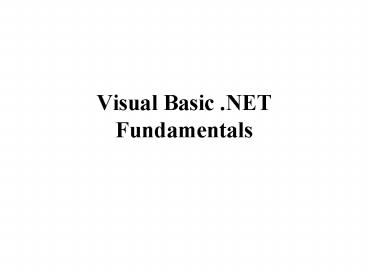Visual Basic .NET Fundamentals PowerPoint PPT Presentation
1 / 12
Title: Visual Basic .NET Fundamentals
1
Visual Basic .NET Fundamentals
2
Objectives
- Use primitive data types, naming conventions, and
style rules - Understand and apply the control structures
supported in Visual Basic .NET - Explain the objects and techniques involved in
the creation of a Multiple Document Interface
(MDI) application - Understand the purpose and uses of these new
Windows Forms controls TabControl, ComboBox,
CheckBox, GroupBox, and RadioButton
3
Using Primitive Data Types, Naming Conventions,
and Style Rules
- Data Types
- Literal
- Has the face value of each occurrence
- Constant
- Is assigned a literal value that does not change
- Variable
- Is a symbolic reference to an address in memory
- Values stored memory block can change during
program execution - Naming Conventions
- Facilitate program readability,
understandability, and maintainability - Programmer-supplied names must be meaningful
- Variable names are mixed case and consist of a
prefix and a meaningful name
4
Using Primitive Data Types, Naming Conventions,
and Style Rules (Continued)
- Example variable declarations
- Dim mdecInterestRate As Decimal - A module-level
decimal - Public pastructUser - A public array of
structures - Static stintLineCtr - A static integer
- Dim strMessage - A dynamic local string
- Naming constants
- Const DAYSINWEEK 7
- Naming functions
- Private Function GetNextRecord()
- Public Sub FindLastName()
- Protected Sub EnableDisableTextboxes(vbln As
Boolean) - Naming classes
- Public Class Student
- Public Class AcademicProgram
- Naming controls
- Controls have a prefix indicating the controls
class
5
Coding Conventions and Style Rules
- Purpose to increase code readability, and,
therefore, make it easier to revise and debug - Using indentation
- To visually identify groups of related statements
- Declaring variables at the lowest level
- If variable needed only inside a procedure,
declare it inside that procedure - If variable needed only in one form, declare it
at form level in that form - If a variable is needed only inside a standard
module, declare it as a Private variable inside
that module - Using constants
- Use constants rather than numeric values when
possible - Constants improve program readability and also
facilitate program maintenance - Writing code that is easy to read
- Try to write code that is easy to read, follow,
and understand
6
Control Structures and Structured Programming
- Control structure
- A method of controlling the execution sequence of
instructions at runtime - Characteristics of structured programs
- Limited to sequence, selection, and iteration,
with unlimited nesting - Every procedure has a single entry point and a
single exit point - Using stepwise refinement, programs are broken
down logically or functionally into relatively
small blocks of code - Variables are declared at lowest possible level
- Global variables are used minimally, if at all
- Stub
- A placeholder for a section of code that will be
developed later
7
Visual Basic .NET Control Structures
- Sequence structure
- One statement after another
- Selection structure
- Includes the If statement, Select Case statement,
Immediate If function, and Try statement - Iteration structures
- Provide for the repeated execution of a statement
block - If statement
- Allows you to specify a condition or test, and if
that condition is met, to then execute one or
more imperative statements
8
Logical Operators
- And
- The result is True only when condition A and
conditionB are both True - Or
- The result is True if at least one of conditionA
or conditionB is True - AndAlso
- The result is True only when conditionA and
conditionB are both True - OrElse
- The result is True if at least one of conditionA
or conditionB is True - Xor
- The result is True only when one and only one of
conditionA and conditionB is True
9
Truth Table for Visual Basic .NET Logical
Operators
10
Visual Basic .NET Control Structures (Continued)
- Select case
- Useful when the evaluation of a single expression
can determine multiple paths - Immediate If (IIf)
- Examines ltconditiongt and returns ltresultAgt if the
condition is True otherwise, it returns
ltresultBgt - Syntax ltvariablegt IIf(ltconditiongt, ltresultAgt,
ltresultBgt) - Try Catch Finally
- Provides a structured programming solution to the
problem of error trapping - Do loops
- Principal form of externally controlled loops
- Pretest loop
- Posttest loop
- While test
- Until test
11
For Loop
- Internally controlled loop
- Requires
- Loop control variable (LCV)
- Initial value for the LCV
- Limit value for the LCV
- Step value
- Test to determine whether the LCVs limit value
has been reached (after which the loop is exited)
12
Using a For Loop for a Sequential Search

